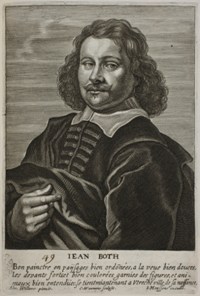Biography
Jan Both was born in Utrecht probably between 1615 and 1618.[1] His father, Dirck Both, a glass painter, may have introduced him to the rudiments of the trade, but he almost certainly received training from a different master as well.[2] A record from the Utrecht Saint Luke’s Guild, presumably referring to Jan, notes that in 1634–1636 a son of Dirck Both was apprenticed to an unnamed master from the guild. This master was probably
Both’s stay in Rome was short-lived. By 1642 he had returned to Utrecht, where he established himself as an independent master, and in that same year he took on his first apprentice, Hendrick Verschuuring (1627–1690).[7] In 1649 Jan was elected overman (regent) of the Saint Luke’s Guild in Utrecht, a post he held jointly with Jan Baptist Weenix (1621–1660/1661) and
It was after his return to Utrecht that Both produced the bulk of his work, which consisted of paintings, drawings, and etchings of pastoral, religious, or mythological subjects set in Italianate landscapes. He received his most important commission, however, while still in Italy. In 1640 Both was among a group of artists, including
According to Both’s earliest biographer, the German artist
[1] The date of Jan’s birth as first documented by Sandrart has been contested by some scholars. De Bruyn places it at about 1618 or slightly later, while Blankert has argued for an earlier date, c. 1615. The Utrecht municipal archives contain no birth or baptismal records before 1612, and records between 1612 and 1626 exist only for two churches.
[2] Arnold Houbraken, De groote schouburgh der Nederlantsche konstschilders en schilderessen, 3 vols. (The Hague, 1753; reprint, Amsterdam, 1976), 2:114.
[3] Joachim von Sandrart, Joachim von Sandrarts Academie der Bau-, Bild- und Mahlerey-Künste von 1675: Leben der berühmten Maler, Bildhauer und Baumeister, ed. A. R. Peltzer (Munich, 1925), 312; Arnold Houbraken, De groote schouburgh der Nederlantsche konstschilders en schilderessen, 3 vols. (The Hague, 1753; reprint, Amsterdam, 1976), 2:114. The Utrecht archives record Andries’ apprenticeship with Bloemaert from 1624 to 1625, though they only name a son of “Dirck Bot.” Scholars have assumed it could only be Andries, given that he was born around 1611–1612, and would have been of appropriate age to hold an apprenticeship in those years. The document is found in Samuel Muller, De Utrechtsche archieven, I: schildersvereeingen te Utrecht (Utrecht, 1880), 118–122.
[4] Joachim von Sandrart, Joachim von Sandrarts Academie der Bau-, Bild- und Mahlerey-Künste von 1675: Leben der berühmten Maler, Bildhauer und Baumeister, ed. A. R. Peltzer (Munich, 1925), 312; Arnold Houbraken, De groote schouburgh der Nederlantsche konstschilders en schilderessen, 3 vols. (The Hague, 1753; reprint, Amsterdam, 1976), 2:114; Malcolm R. Waddingham, “Andries and Jan Both in France and Italy,” Paragone 171 (1964): 19; James Burke, Jan Both: Paintings, Drawings, and Prints (New York, 1976), 34. Andries was first recorded in the French city of Rouen in 1633 and then in Rome in 1635.
[5] G. J. Hoogewerff, Bescheiden in Italië omtrent Nederlandsche kunstenaars en geleerden, 3 vols. (The Hague, 1917), 53.
[6] G. J. Hoogewerff, Nederlandsche kunstenaars te Rome (1600–1725): uittreksels uit de parochiale archieven (The Hague, 1942), 108, 110. Jan and Andries are listed in both years under Strada Vittoria, dal Corso mano sinistra: Giovanni But di Olanda and Andrea But, fratello.
[7] Arnold Houbraken, De groote schouburgh der Nederlantsche konstschilders en schilderessen, 3 vols. (The Hague, 1753; reprint, Amsterdam, 1976), 2:193.
[8] Samuel Muller, De Utrechtsche archieven, I: schildersvereeingen te Utrecht (Utrecht, 1880), 129.
[9] James Burke, Jan Both: Paintings, Drawings, and Prints (New York, 1976), 35: Gemeente Archief, Utrecht, Begrafenisregister.
[10] Joachim von Sandrart, Joachim von Sandrarts Academie der Bau-, Bild- und Mahlerey-Künste von 1675: Leben der berühmten Maler, Bildhauer und Baumeister, ed. A. R. Peltzer (Munich, 1925), 312.
[11] Joachim von Sandrart, Joachim von Sandrarts Academie der Bau-, Bild- und Mahlerey-Künste von 1675: Leben der berühmten Maler, Bildhauer und Baumeister, ed. A. R. Peltzer (Munich, 1925), 312. This collaboration ended when Andries drowned in a Venetian canal on March 23, 1642, on his return trip to the Netherlands.
[12] C. H. de Jonge, “Utrechtse schilders der XVIIde eeuw in de verzameling van Willem Vincent, baron van Wyttenhorst,” Oudheidkundig Jaarboek, 4th serv. (1932): 123.
Arthur K. Wheelock Jr.,
Lara Yeager-Crasselt
April 24, 2014
